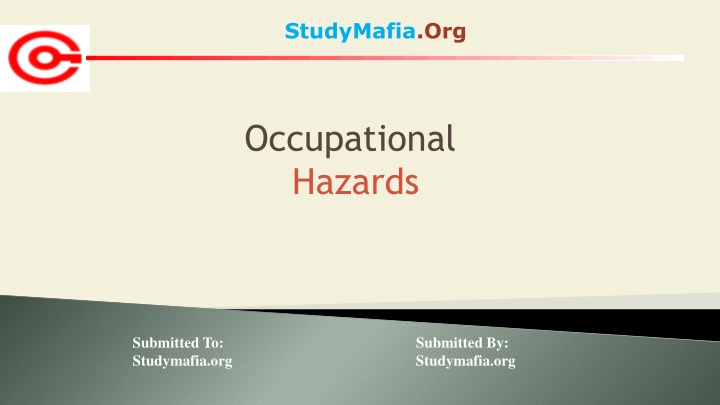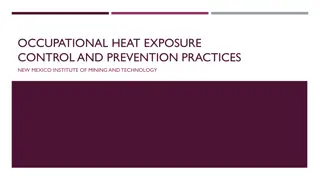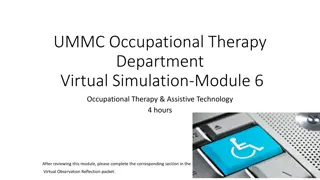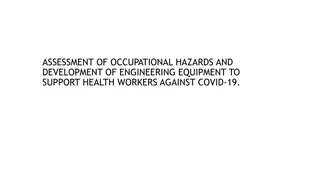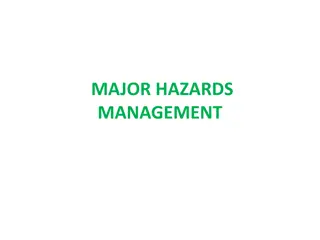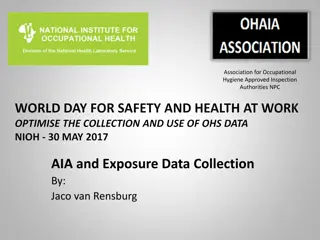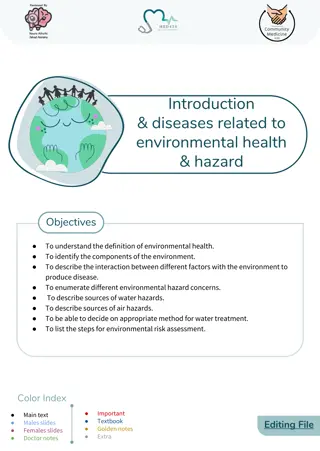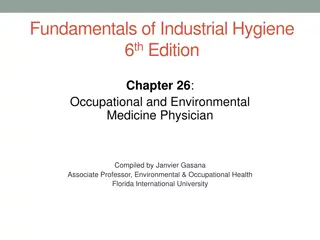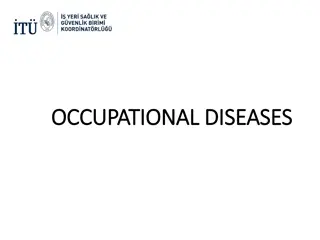Occupational Hazards: Causes, Diseases, Prevention
Occupational hazards are health risks related to work environment exposure. They encompass physical, chemical, biological, ergonomic, and psychosocial factors that can lead to diseases. These diseases may manifest clinically even after exposure has ceased, like asbestos-related mesothelioma. Understanding the clinical manifestations and effects of occupational factors is crucial for prevention and proper management, as they can interact with non-occupational factors to worsen health outcomes. Learn about the various occupational hazards and how to prevent them effectively to ensure a safer work environment.
Uploaded on Mar 05, 2025 | 0 Views
Download Presentation

Please find below an Image/Link to download the presentation.
The content on the website is provided AS IS for your information and personal use only. It may not be sold, licensed, or shared on other websites without obtaining consent from the author.If you encounter any issues during the download, it is possible that the publisher has removed the file from their server.
You are allowed to download the files provided on this website for personal or commercial use, subject to the condition that they are used lawfully. All files are the property of their respective owners.
The content on the website is provided AS IS for your information and personal use only. It may not be sold, licensed, or shared on other websites without obtaining consent from the author.
E N D
Presentation Transcript
StudyMafia.Org Occupational Hazards Submitted To: Studymafia.org Studymafia.org Submitted By:
Definition Factors causing Occupational Hazards. Characteristics of Occupational Hazards. Diseases Caused by Occupational Hazards. Prevention of Occupational Hazards. Conclusion
Occupational diseases are adverse health conditions in the human being, the occurrence or severity of which is related to exposure to factors on the job or in the work environment.
Physical: e.g. heat, noise, radiation Chemical: e.g. solvents, pesticides, heavy metals, dust Biological: e.g. tuberculosis, hepatitis B virus, HIV Ergonomic: e.g. improperly designed tools or work areas, repetitive motions Psychosocial stressors: e.g. lack of control over work, inadequate personal support Mechanical: these mainly cause work accidents and injuries rather than occupational diseases.
The clinical and pathological presentation are identical to that of non-occupational diseases; e.g. asthma Occupational disease may occur after the termination of exposure. Eg: asbestos-related mesothelioma (a cancer affecting the lung and abdomen) which can occur 30 or 40 years after the exposure.
The clinical manifestations of occupational disease are related to the dose and timing of exposure; e.g. at very high airborne concentrations, elemental mercury is acutely toxic to the lungs and can cause pulmonary failure, while at lower levels of exposure, elemental mercury has no pathologic effect on the lungs but can have chronic adverse effects on the central and peripheral nervous systems. Occupational factors can act in combination with non- occupational factors to produce disease; e.g. exposure to asbestos (five-fold increase in lung cancer ); and the long- term smoking of cigarettes (increases the risk by 50 and 70 fold.
PHYSICAL AGENTS PHYSICAL AGENTS Heat Heat hyperpyrexia, exhaustion, syncope, cramps, burns Cold Trench foot, frost bite Light Occupational cataracts, miner s nystagmus Pressure Caisson disease, air embolism, blast (explosion) Noise Occupational deafness Radiation Cancers, leukemias, aplastic anemia, pancytopenia Mechanical factors Injuries, accidents Electricity Burns
CHEMICAL Gases Dusts (pneumoconiosis) CHEMICAL AGENTS AGENTS CO2, CO, HCN, N2,NH3,HCL Coal dust (anthracosis), silica (silicosis), asbestos (asbestosis, Ca lung), iron (siderosis) Cane fiber (bagassosis), cotton dust (byssinosis), tobacco (tobacossosis), hay or grain dust (farmers lung) Toxicity from Lead, mercury, cadmium, mercury, arsenic Acids, alkalis, pesticides Brucellosis, leptospirosis, anthrax, tetanus, encephalitis, fungal infections Skin, lung, bladder Dermatitis and eczema Industrial neurosis, hypertension, peptic ulcer Metals and their compounds Chemicals Biological agents Occupational cancers Occupational dermatosis Psychological origin
Pneumoconiosis is disabling pulmonary fibrosis that results from the inhalation of various types of inorganic dust, such as silica, asbestos, coal, talc and china clay. e.g. silicosis and asbestosis
Crystalline silica (SiO2) Occupations: mining (coal, mica, gold, silver, lead, zn) stone cutting and shaping, sandblasting (building and construction) glass and ceramics manufacture Iron and steel industry Occupations: Time to develop: concentrations of dust Presentation: respiratory failure , impaired TLC (total lung capacity) Diagnosis: Progressive disease and converts to TB Time to develop: 7 10 years, sometimes less. Prolonged exposure to higher Presentation: dyspnoea on exertion , pulmonary tuberculosis and cardiac or Diagnosis: x-ray .snow storm appearance Progressive disease and converts to TB prevention and regular physical examinations prevention and regular physical examinations
Inhalation of asbestos fibres Occupations: mining and extraction exposure to asbestos insulation making of asbestos cloth manufacture of asbestos cement pipes and other products, vinyl floor tiles and in brake and cloth lining Sign & symptoms: calcification. Bronchogenic carcinoma, pleural and peritoneal mesothelioma progressive dyspnoea on exertion, cough, expectoration, chest pain, cyanosis and clubbing of the fingers Diagnosis: fibrin), X-ray findings , ground- glass appearance in lower 2/3 rd lung Progressive diseases prevention and periodic examinations Sign & symptoms: interstitial fibrosis of the lungs, pleural thickening, Diagnosis: asbestos bodies in sputum (asbestos fibres coated with Progressive diseases prevention and periodic examinations
Lab diagnosis: Coproporphyrin in urine (screening test) Amino levulinic acid in urine Lead levels in blood and urine Prevention: Substitution Isolation Local exhaust ventilation Personal protection Periodic examinations personal hygiene; handwashing Health education
Carcinogenic agent Arsenic Chromium compounds, hexavalents Nickel Polycyclic aromatic hydrocarbons Coal tars bladder Benzol B-naphthalamine Bladder Ionizing radiation blood (leukaemia) Asbestos Carcinogenic agent Organ affected Skin and lung Organ affected Lung Lung and nasal sinus Skin Skin, scrotum, lung, Blood (leukaemia) Skin, bone, lung, Lung, pleura, peritoneum
Causes: Heat, cold, moisture, friction, pressure, x-rays, acids, alkalis, solvents, grease, tar, pitch, bacteria, fungi, leaves, vegetables, fruits Classification Primary irritants Sensitizing substances Prevention: Pre-selection Protection Personal hygiene Periodic assessments Causes: Classification Prevention:
Industrial exposures: for watches, mining of radioactive ores, sand workers, x-rays rooms Effects of radiation: effects. Prevention : Shielding in x-ray areas, monitoring 6 monthly, for their film badge or pocket electronic device, adequate workplace ventilation, replacement and periodic exams. Pregnant ladies should not be allowed to work in the area Industrial exposures: manufacture of radioactive paints, painting of luminous dials Effects of radiation: Acute burns, dermatitis, blood dyscrasis, malignancies, genetic Prevention :
Pre-placement exams Periodic examinations Medical and health care services Notifications Supervision of working environment Maintenance and analysis of records Health education and counseling
Designing of the buildings Good house keeping General ventilation Substitution Dusts Enclose Isolate Local exhausts ventilations Protective devices Environmental monitoring Research
Occupational safety and health should not be sidelined as a service delivery issue. Health worker health and well-being is an important aspect of workers motivation and job satisfaction, which influence productivity as well as retention. Health worker safety also affects the quality of care; caring for the caregiver should be a priority area of concern for the health system s performance. What is good for employee health is good for patient health.
Google.com Wikipedia.org Studymafia.org Slidespanda.com
